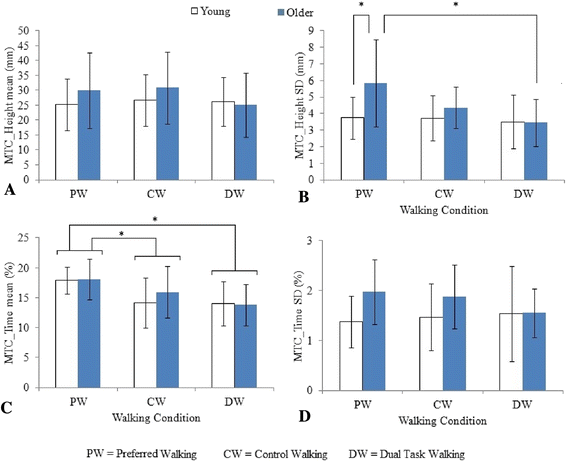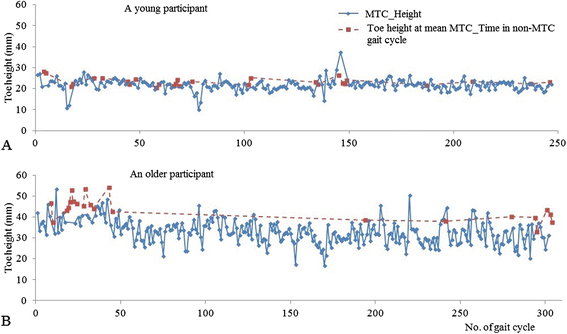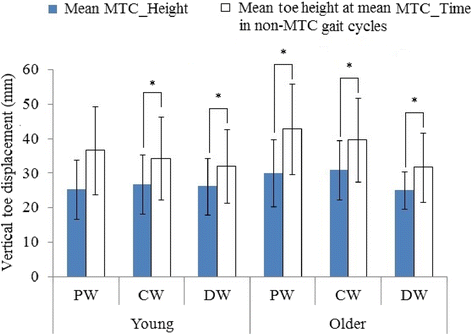Minimum toe clearance events in divided attention treadmill walking in older and young adults: a cross-sectional study
- PMID: 26162824
- PMCID: PMC4499197
- DOI: 10.1186/s12984-015-0052-2
Minimum toe clearance events in divided attention treadmill walking in older and young adults: a cross-sectional study
Abstract
Background: Falls in older adults during walking frequently occur while performing a concurrent task; that is, dividing attention to respond to other demands in the environment. A particularly hazardous fall-related event is tripping due to toe-ground contact during the swing phase of the gait cycle. The aim of this experiment was to determine the effects of divided attention on tripping risk by investigating the gait cycle event Minimum Toe Clearance (MTC).
Methods: Fifteen older adults (mean 73.1 years) and 15 young controls (mean 26.1 years) performed three walking tasks on motorized treadmill: (i) at preferred walking speed (preferred walking), (ii) while carrying a glass of water at a comfortable walking speed (dual task walking), and (iii) speed-matched control walking without the glass of water (control walking). Position-time coordinates of the toe were acquired using a 3 dimensional motion capture system (Optotrak NDI, Canada). When MTC was present, toe height at MTC (MTC_Height) and MTC timing (MTC_Time) were calculated. The proportion of non-MTC gait cycles was computed and for non-MTC gait cycles, toe-height was extracted at the mean MTC_Time.
Results: Both groups maintained mean MTC_Height across all three conditions. Despite greater MTC_Height SD in preferred gait, the older group reduced their variability to match the young group in dual task walking. Compared to preferred speed walking, both groups attained MTC earlier in dual task and control conditions. The older group's MTC_Time SD was greater across all conditions; in dual task walking, however, they approximated the young group's SD. Non-MTC gait cycles were more frequent in the older group across walking conditions (for example, in preferred walking: young - 2.9 %; older - 18.7 %).
Conclusions: In response to increased attention demands older adults preserve MTC_Height but exercise greater control of the critical MTC event by reducing variability in both MTC_Height and MTC_Time. A further adaptive locomotor control strategy to reduce the likelihood of toe-ground contacts is to attain higher mid-swing clearance by eliminating the MTC event, i.e. demonstrating non-MTC gaits cycles.
Figures




Similar articles
-
Non-MTC gait cycles: An adaptive toe trajectory control strategy in older adults.Gait Posture. 2017 Mar;53:73-79. doi: 10.1016/j.gaitpost.2016.11.044. Epub 2016 Nov 29. Gait Posture. 2017. PMID: 28113075
-
Tone Entropy Analysis of Augmented Information Effects on Toe-Ground Clearance When Walking.IEEE Trans Neural Syst Rehabil Eng. 2016 Nov;24(11):1218-1224. doi: 10.1109/TNSRE.2016.2538294. Epub 2016 Apr 7. IEEE Trans Neural Syst Rehabil Eng. 2016. PMID: 27071178
-
Investigating scale invariant dynamics in minimum toe clearance variability of the young and elderly during treadmill walking.IEEE Trans Neural Syst Rehabil Eng. 2008 Aug;16(4):380-9. doi: 10.1109/TNSRE.2008.925071. Epub 2008 May 16. IEEE Trans Neural Syst Rehabil Eng. 2008. PMID: 18713677
-
A Scoping Review on Minimum Foot Clearance: An Exploration of Level-Ground Clearance in Individuals with Abnormal Gait.Int J Environ Res Public Health. 2021 Sep 29;18(19):10289. doi: 10.3390/ijerph181910289. Int J Environ Res Public Health. 2021. PMID: 34639597 Free PMC article.
-
A Scoping Review on Minimum Foot Clearance Measurement: Sensing Modalities.Int J Environ Res Public Health. 2021 Oct 15;18(20):10848. doi: 10.3390/ijerph182010848. Int J Environ Res Public Health. 2021. PMID: 34682592 Free PMC article.
Cited by
-
Minimum toe clearance: probing the neural control of locomotion.Sci Rep. 2017 May 15;7(1):1922. doi: 10.1038/s41598-017-02189-y. Sci Rep. 2017. PMID: 28507300 Free PMC article.
-
Effects of Cognitive-Motor and Motor-Motor Dual Tasks on Gait Performance in Older Adults with Sarcopenia.Healthcare (Basel). 2024 Jun 17;12(12):1206. doi: 10.3390/healthcare12121206. Healthcare (Basel). 2024. PMID: 38921320 Free PMC article.
-
A cross-sectional study of foot-ground clearance in healthy community dwelling Japanese cohorts aged 50, 60 and 70 years.BMC Geriatr. 2021 Mar 6;21(1):166. doi: 10.1186/s12877-021-02117-w. BMC Geriatr. 2021. PMID: 33676395 Free PMC article.
-
The effects of cognitive tasks on the frequency of non-MTC gait cycle during walking in healthy older and young adults.J Phys Ther Sci. 2022 Jul;34(7):497-502. doi: 10.1589/jpts.34.497. Epub 2022 Jul 1. J Phys Ther Sci. 2022. PMID: 35784603 Free PMC article.
-
The impact of slip perturbations on minimum toe clearance during walking in younger and older adults.PLoS One. 2025 May 23;20(5):e0323307. doi: 10.1371/journal.pone.0323307. eCollection 2025. PLoS One. 2025. PMID: 40408347 Free PMC article.
References
-
- Australian Commission on Safety and Quality in Health Care. [http://www.safetyandquality.gov.au/wp-content/uploads/2013/10/Final-tagg...]
-
- Ten Leading Causes of Death and Injury. [http://www.cdc.gov/injury/wisqars/LeadingCauses.html]
MeSH terms
LinkOut - more resources
Full Text Sources
Other Literature Sources
Medical

